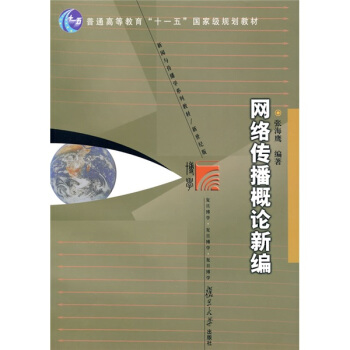

具体描述
编辑推荐
《计算机英语(第五版)(计算机系列教材)》是计算机专业英语的经典教材,累计出版了5个版本,应用广泛,近60万学子使用本书。
按计算机的知识结构层次编写。内容涵盖以下三个部分:计算机和计算机网络硬件结构、计算机软件和因特网应用。
尽量吸取最先进的技术和知识,包括云计算、大数据、3D打印技术、工业4.0和慕课等。鉴于因特网应用发展异常迅猛,本书有约三分之一的篇幅是讲述因特网应用的。
书中对一些较难翻译和理解的句子、单词进行了注释;每一节后面列出关键词汇,给出联系题;书后还给出参考译文,供读者参考。
内容简介
《计算机英语(第五版)(计算机系列教材)》计算机及相关专业的专业英语教材,是按计算机的知识结构层次编写的。内容涵盖以下三个部分:计算机及计算机网络硬件结构(第1章和第3章),计算机软件(第2章、第6章为系统软件,第7、8、9、10、11章为应用软件)和因特网应用(第4、5章)。在具体内容的选取上,除了基础知识以外,尽量吸取最先进的技术和知识,这其中包括云计算、大数据、3D打印技术、工业4.0和慕课等。鉴于因特网应用发展异常迅猛,本书有19课(约占全书59课的1∕3)涉及因特网应用。
为便于读者阅读,书中对一些较难理解和翻译的句子做了注释,对遇到的专业术语也都做了解释。
本书主要用作大学计算机及相关专业本科生、专科生的教材,也可供研究生及参加计算机水平考试的考生使用。
目录
PART Ⅰ COMPUTER ARCHITECTURE
AND COMPUTER NETWORK
CHAPTER 1 COMPUTER ORGANIZATION AND
UNITS /3
1.1 COMPUTER ORGANIZATION /3
1.2 MICROPROCESSOR AND SYSTEM
BOARD /10
1.3 MEMORY /15
1.4 SECONDARY STORAGES /19
1.5 INPUT AND OUTPUT DEVICES /27
CHAPTER 2 SYSTEM SOFTWARE /40
2.1 COMPUTER SOFTWARE /40
2.2 SUMMARY OF OPERATING SYSTEM /43
2.3 WINDOWS 10 /47
2.4 UNIX AND LINUX /52
2.5 MAC OS /57
2.6 ANDROID /60
CHAPTER 3 COMPUTER NETWORK /65
3.1 LOCAL AREA NETWORKS (LANs) /65
3.1.1 ETHERNET /65
3.1.2 Wi-Fi AND BLUETOOTH /69
3.1.3 HOME NETWORK /74
3.2 WIDE AREA NETWORKS (WANs) /76
3.2.1 OVERVIEW OF WIDE AREA
NETWORKS (WANs) /76
3.2.2 STORAGE AREA NETWORK (SAN)
AND INTERNET AREA NETWORK
(IAN) /81
3.3 THE INTERNET /83
PART Ⅱ INTERNET APPLICATIONS
CHAPTER 4 TRADITIONAL INTERNET
APPLICATIONS /93
4.1 OVERVIEW OF WORLD WIDE
WEB (WWW) /93
4.1.1 ABOUT WWW /93
4.1.2 SEARCH ENGINES /97
4.2 E-MAIL /100
4.3 ELECTRONIC COMMERCE AND THE
INTERNET OF THINGS /103
4.3.1 ELECTRONIC COMMERCE AND
SOCIAL COMMERCE /103
4.3.2 INTERNET OF THINGS /111
4.4 COMPUTER AND NETWORK
SECURITY /115
4.4.1 COMPUTER CRIMINALS AND
CRIME /115
4.4.2 PROTECT COMPUTER
SECURITY /120
CHAPTER 5 NEW INTERNET APPLICATIONS
/123
5.1 INSTANT MESSAGING (IM) /123
5.1.1 OVERVIEW OF INSTANT
MESSAGING (IM) /123
5.1.2 QQ /126
5.1.3 FACEBOOK /129
5.1.4 TWITTER /132
5.1.5 MICROSOFT SERVICE NETWORK
(MSN) /134
5.1.6 WECHAT /138
5.2 SOCIAL NETWORKING SERVICE
(SNS) /140
5.2.1 OVERVIEW OF SOCIAL
NETWORKING SERVICE (SNS) /140
5.2.2 WIKI /144
5.2.3 BLOG AND MICROBLOG /146
5.3 CLOUD COMPUTING /151
5.4 BIG DATA /158
5.5 MOOC AND FLIPPED THE CLASS
ROOM /163
PART Ⅲ PROGRAM DESIGN LANGUAGES
AND DATABASES
CHAPTER 6 PROGRAMMING LANGUAGES /173
6.1 OVERVIEW OF PROGRAMMING
LANGUAGES /173
6.2 C, C++, AND C# /177
6.3 JAVA /181
6.4 MARKUP AND SCRIPTING
LANGUAGES /185
CHAPTER 7 DATABASE /192
7.1 DATABASE CONCEPTS /192
7.2 THE WEB AND DATABASES /197
7.3 MySQL /201
PART Ⅳ APPLICATION SOFTWARE
CHAPTER 8 OFFICE AUTOMATION
SOFTWARE /209
8.1 THE BASICS OF OFFICE AUTOMATION
SOFTWARE /209
8.2 MICROSOFT OFFICE 2013 /215
8.3 MICROSOFT OFFICE MOBILE /220
CHAPTER 9 MULTIMEDIA /224
9.1 MULTIMEDIA AND ITS MAJOR
CHARACTERISTICS /224
9.2 USAGE/APPLICATION /227
9.3 MULTIMEDIA NETWORKING /232
CHAPTER 10 COMPUTER GRAPHICS AND
IMAGES /235
10.1 OVERVIEW /235
10.2 THE VARIOUS COMPUTER
GRAPHICS /237
10.3 GRAPHICS SOFTWARE (1) /241
10.4 GRAPHICS SOFTWARE (2) /246
10.5 DIGITAL IMAGE FILE FORMATS /249
CHAPTER 11 MODERN INDUSTRIAL
AUTOMATION /253
11.1 OVERVIEW /253
11.2 USE OF CAD, CAM, AND CAE /256
11.3 PRODUCT LIFECYCLE MANAGEMENT
(PLM) /260
11.4 INDUSTRY 4.0 /265
11.5 3D PRINTING /270
ANSWERS TO THE EXERCISES /277
BIBLIOGRAPHY /282
参考译文 /283
第一部分 计算机体系结构和计算机网络 /283
第1章 计算机组成和部件 /283
1.1 计算机组成 /283
1.2 微处理器和系统板 /285
1.3 存储器 /286
1.4 二级存储器 /288
1.5 输入与输出设备 /290
第2章 系统软件 /294
2.1 计算机软件 /294
2.2 操作系统概述 /296
2.3 Windows 10 /297
2.4 UNIX和LINUX /299
2.5 Mac操作系统 /300
2.6 安卓操作系统 /301
第3章 计算机网络 /303
3.1 局域网 /303
3.1.1 以太网 /303
3.1.2 Wi-Fi和蓝牙 /304
3.1.3 家庭网 /305
3.2 广域网 /305
3.2.1 广域网概述 /305
3.2.2 存储区域网和因特网区
域网 /307
3.3 因特网 /308
第二部分 因特网应用 /310
第4 章 传统因特网应用 /310
4.1 万维网概述 /310
4.1.1 关于万维网 /310
4.1.2 搜索引擎 /311
4.2 电子邮件 /312
4.3 电子商务和物联网 /313
4.3.1 电子商务和社会商务 /313
4.3.2 物联网 /315
4.4 计算机和网络安全 /316
4.4.1 计算机罪犯和犯罪 /316
4.4.2 保护计算机安全 /318
第5章 因特网新应用 /319
5.1 即时消息 /319
5.1.1 即时消息概述 /319
5.1.2 QQ /320
5.1.3 脸谱 /321
5.1.4 推特 /322
5.1.5 微软服务网MSN /323
5.1.6 微信 /324
5.2 社交网络服务 /324
5.2.1 社交网络服务概述 /324
5.2.2 维基 /325
5.2.3 博客与微博 /326
5.3 云计算 /327
5.4 大数据 /329
5.5 慕课与翻转课堂 /331
第三部分 程序设计语言和数据库 /333
第6章 程序设计语言 /333
6.1 程序设计语言概述 /333
6.2 C、C++ 和 C# /335
6.3 Java /336
6.4 标记和脚本语言 /337
第7章 数据库 /339
7.1 数据库的概念 /339
7.2 万维网与数据库 /341
7.3 MySQL /342
第四部分 应用软件 /343
精彩书摘
CHAPTER 5 NEW INTERNET APPLICATIONS
5.1 INSTANT MESSAGING (IM)
5.1.1 OVERVIEW OF INSTANT MESSAGING (IM)
Instant messaging (IM) is an extension of e-mail that allows two or more people to contact each other via direct, live communication. To use instant messaging, you specify a list of friends and register with an instant messaging server. Whenever you connect to the Internet, special software informs your messaging server that you are online. [1] In response, the server will notify you if any of your contacts are online. At the same time, it notifies your friends that you are online. You can then send messages directly back and forth to one another. Most instant messaging programs also include video conferencing features, file sharing, and remote assistance. Many businesses routinely use these instant messaging features.
Instant messaging is a popular variation of chat in which you are informed when someone on your buddy list—a list containing the names of friends and associates that you specify—are on line; when they are on line, you can send them a message that immediately appears on their screen (See Figure 5-1).[2] You can then have a real—time typed conversation.
Figure 5-1 Instant Messaging
As of 2010, social networking providers often offer IM abilities. Facebook Chat is a form of instant messaging, and Twitter can be thought of as a Web 2.0 instant messaging system[3]. Similar server-side chat features are part of most dating websites, such as OKCupid or Plenty of Fish[4]. The spread of smartphones and similar devices in the late 2000s also caused increased competition with conventional instant messaging, by making text messaging services still more ubiquitous.
Many instant messaging services offer video calling features, voice over IP and web conferencing services[5]. Web conferencing services can integrate both video calling and instant messaging abilities. Some instant messaging companies are also offering desktop sharing, IP radio, and IPTV to the voice and video features[6].
Each modern IM service generally provides its own client, either a separately installed piece of software, or a browser-based client. These usually only work with the supplier company’s service, although some allow limited function with other services. Third party client software applications exist, that will connect with most of the major IM services. Adium, Empathy, Miranda IM, Pidgin, Qnext and Trillian are a few of the common ones[7].
Standard complementary instant messaging applications offer functions like file transfer, contact list(s), the ability to hold several simultaneous conversations, etc. These may be all the functions that a small business needs, but larger organizations will require more sophisticated applications that can work together[8]. The solution to finding applications capable of this is to use enterprise versions of instant messaging applications. These include titles like XMPP, Lotus Sametime, Microsoft Office Communicator, etc., which are often integrated with other enterprise applications such as workflow systems[9]. These enterprise applications, or enterprise application integration (EAI), are built to certain constraints, namely storing data in a common format.
……
前言/序言
《计算机英语(第四版)》出版6年以来,计算机和因特网又出现了很多新技术,为了适应这种新的形势,编写了第五版。第五版只保留了第四版中计算机和网络的基础内容,超过80%是新内容。考虑到长期使用本教材的教师和读者的用书习惯,本书编写格式与第四版保持一致,即课文中有注释、关键词和练习题,书后附有习题答案和参考译文。
本书由刘兆毓、郑家农等编著,全书共11章,46节(内含59课),其中郑家农编写了第9~11章,闫金平编写了第1、3章,刘华群编写了第2、6章,武华编写了第4、8章,刘兆毓编写了第5、7章。
本书在编写过程中,引用了刘艺、王春生编写的《计算机英语(第4版)》的部分内容,在此表示感谢。
由于作者水平有限,书中难免有不当之处,敬请批评指正。
编者
2017年10月于北京
用户评价
在我看来,《计算机英语(第五版)/计算机系列教材》是一本能够帮助我“看得懂”和“说得出来”的关键性教材。它对于“计算机网络”的学习,起到了至关重要的作用。我至今仍然记得书中对“HTTP协议”的详细讲解,它不仅列出了“request,” “response,” “header,” “body,” “method,” “status code”等关键术语,更重要的是,它通过图示和案例,清晰地解释了这些术语在实际网络通信中的作用。这让我能够更好地理解网页是如何加载的,以及浏览器和服务器之间是如何交互的。书中还提供了许多关于网络安全协议的英文介绍,例如SSL/TLS的握手过程,以及相关的加密算法,这让我能够更深入地了解网络安全的重要性。我特别欣赏书中提供的“阅读理解”部分,选取的文章都是当时比较热门的网络技术话题,例如“CDN技术”和“IPv6的推广”,这不仅拓宽了我的知识面,也让我能够接触到地道的英文技术表达。这本书的价值在于,它不仅仅教授我语言,更是在教授我如何用英语来理解和分析计算机网络领域的各种技术问题。
评分我不得不说,《计算机英语(第五版)/计算机系列教材》在我学习计算机科学的道路上,起到了“润物细无声”的关键作用。它不像某些教材那样枯燥乏味,而是通过精心设计的版块和引人入胜的内容,让我对计算机英语的学习充满了积极性。我记得书中有专门介绍“软件开发生命周期”的章节,它不仅提供了相关的专业词汇,更重要的是,通过图文并茂的方式,清晰地展示了从需求分析到维护的各个阶段,并为每个阶段提供了典型的英文描述和常用表达。这让我第一次真正理解了,原来那些看似抽象的计算机概念,都可以用规范、精确的英语来表达。书中对“数据库管理系统”的讲解也让我受益匪浅,它不仅解释了SQL的常用命令,还提供了构建简单数据库的示例代码,让我能够边学英语,边动手实践。这种“学以致用”的学习模式,极大地提升了我的学习效率和兴趣。我还会经常翻阅书中的“科技前沿”专栏,里面介绍了一些当时比较热门的技术,比如“云计算”和“大数据”,并配有相应的英文阅读材料。这些内容不仅让我了解了最新的技术动态,也帮助我掌握了相关的英语表达方式,让我能够更好地理解和讨论这些前沿话题。总的来说,这本书为我构建了一个完整的计算机英语学习体系,它不仅仅是教授我单词和语法,更是培养我用英语思维来理解和表达计算机知识的能力。
评分这本书,我用了不止四年,从本科到研究生,再到刚工作的那段时间,它都一直放在我的书架上,时不时地翻出来查阅。我尤其欣赏它在“计算机网络”部分的细致讲解。当我在学习TCP/IP协议栈时,书中对每一个层级的概念、工作原理以及相关的英文术语都进行了清晰的阐述。比如,“SYN/ACK handshake”的流程,书中不仅给出了详细的文字解释,还配有流程图,让我能够直观地理解三次握手的过程,以及与之相关的“synchronization,” “acknowledgement,” “sequence number”等关键术语。这比我单独去看枯燥的协议文档要容易理解得多。此外,书中对于“网络安全”的介绍也让我印象深刻。它涵盖了诸如“firewall,” “encryption,” “authentication,” “intrusion detection system”等核心概念,并提供了相关的英文例句,让我能够更准确地描述和理解网络攻击与防御的原理。我记得在一次课程设计中,需要撰写一份关于网络安全评估的报告,书中提供的许多句型和专业词汇直接派上了用场,让我的报告显得更加专业和规范。这本书的优点在于,它不是简单地罗列词汇,而是将词汇置于具体的语境中,通过大量的实例和应用场景,帮助读者真正理解和掌握它们。它更像是为我量身打造的“翻译官”,让我能够跨越语言障碍,深入探索计算机世界的奥秘。
评分这本《计算机英语(第五版)/计算机系列教材》无疑是我在计算机领域学习道路上的一盏明灯。它对我理解“软件开发过程”有着极其深刻的影响。我记得书中对于“版本控制系统”的介绍,它详细讲解了Git等工具的核心概念,如“commit,” “branch,” “merge,” “pull request”等,并提供了大量使用这些命令的英文示例。这让我能够迅速上手,并在多人协作的项目中,与团队成员进行有效的沟通。书中还对“敏捷开发”方法进行了深入剖析,解释了Scrum、Kanban等框架的英文术语和实践流程,这让我能够更好地理解现代软件开发的工作模式。我特别欣赏的是,书中提供的许多案例分析,都是基于真实的项目场景,这使得学习内容更具象化,也更容易被我吸收。例如,在讲述“单元测试”时,它不仅给出了相关的英文术语,还提供了一些测试框架的英文文档片段,引导我如何阅读和理解这些文档。这本书的价值在于,它不仅仅教授我语言,更教授我如何在计算机专业领域进行有效的沟通和协作。
评分《计算机英语(第五版)/计算机系列教材》在我看来,是一本极具实用价值的学习工具,它成功的关键在于其内容的前瞻性和深度。我尤其记得书中对“人工智能”和“机器学习”的介绍,在当时(虽然现在来看依然重要)可能算是比较新的领域,但书中已经对其核心概念,如“neural networks,” “deep learning,” “supervised learning,” “unsupervised learning”等进行了详细的解释,并且提供了大量的英文阅读材料。这极大地帮助我拓宽了对AI领域的认知,也让我能够初步接触到该领域的英文文献。书中不仅仅是翻译,更多的是对计算机概念的英文解释,以及如何在学术和技术交流中使用这些表达。比如,在解释“算法复杂度”时,它详细介绍了Big O notation及其在描述算法效率中的应用,并提供了很多关于分析算法性能的英文范例,这对我理解和比较不同算法的优劣非常有帮助。我还记得书中有关于“软件工程”方法的介绍,比如敏捷开发(Agile Development)和瀑布模型(Waterfall Model),书中不仅解释了这些方法的英文术语,还列举了项目管理、需求分析、测试等环节中常用的英文表达,让我能够更好地理解相关的英文技术文档和项目管理流程。这本书的价值在于,它不是一成不变的,而是随着技术的发展不断更新,为我提供了一个持续学习和进步的平台。
评分这本《计算机英语(第五版)/计算机系列教材》在我大学生涯中扮演了至关重要的角色,尤其是对于我这个当初对英语感到些许畏惧,又对计算机科学充满好奇的学生来说。初次翻开它,我就被其系统性的编排所吸引。它不仅仅是一本简单的词汇手册,更是一座连接我理解计算机专业概念和掌握英语表达能力的桥梁。书中的例句选择非常贴合计算机领域的实际应用,涵盖了从基础的硬件组件到复杂的软件开发流程,再到前沿的网络技术和人工智能的讨论。我至今仍然清晰地记得,书中对于“algorithm”这个词的解释,它不仅给出了标准的英文定义,还辅以非常形象的类比,让我这个初学者一下子就抓住了核心概念。更难得的是,它还列举了许多在学术论文、技术文档和产品说明书中常见的固定搭配和句型,这对于我后来阅读英文技术博客、参与开源项目讨论,甚至是尝试撰写简单的技术报告都大有裨益。每一章的练习题设计也十分巧妙,从单项选择、填空,到翻译句子、段落写作,循序渐进,有效地巩固了所学知识。我尤其喜欢其中的“阅读理解”部分,选取的文章话题广泛,语言地道,既能提升阅读速度和理解能力,又能拓展我的计算机知识面。说实话,如果没有这本书打下坚实的基础,我可能很难在后续的学习和工作中,自如地驾驭海量的英文技术资料,甚至不敢轻易地在国际技术社区发表自己的见解。它就像一个忠实可靠的伙伴,默默地陪伴我走过了从“听不懂、看不懂”到“能交流、能表达”的转变过程。
评分我必须强调,《计算机英语(第五版)/计算机系列教材》在我整个大学的学习生涯中,都是一本不可或缺的参考书。它让我真正意识到,掌握计算机英语不仅仅是认识几个单词,更是理解一种思维方式和表达习惯。我特别欣赏书中关于“操作系统”的讲解,它不仅仅列出了“process,” “thread,” “memory management,” “file system”等词汇,更重要的是,它通过清晰的图示和生动的比喻,解释了这些概念在实际操作系统中的运作原理。并且,书中还提供了许多与操作系统相关的英文研究论文和技术报告的片段,引导我如何去阅读和理解这些复杂的文本。这对于我后来撰写操作系统相关的课程论文,以及理解更深层次的系统原理,都起到了至关重要的作用。我还记得书中关于“程序设计语言”的介绍,它不仅对比了不同编程语言的特点,还提供了大量关于语法、语义、编译和解释的英文描述。这帮助我摆脱了仅仅局限于代码层面理解编程语言的局限,上升到了对其原理的更深层次的认识。这本书的编排逻辑非常清晰,每一章都围绕一个核心主题展开,从基础词汇到进阶应用,循序渐进,让学习过程更加顺畅。
评分坦白说,《计算机英语(第五版)/计算机系列教材》在我看来,是一本能够帮助我“看得懂”和“说得出来”的关键性教材。它对于“数据结构”的阐释,我至今记忆犹新。书中不仅介绍了数组(array)、链表(linked list)、栈(stack)、队列(queue)、树(tree)、图(graph)等基本数据结构,更重要的是,它提供了这些数据结构在不同应用场景下的英文描述,以及相关的英文术语,如“traversal,” “insertion,” “deletion,” “recursion”等。这让我能够不仅仅停留在理论层面,更能将其与实际的编程应用结合起来。我记得书中有一部分专门讨论“算法分析”,它详细地解释了时间复杂度和空间复杂度,并且提供了很多用英文分析算法性能的例子。这对我后来学习算法设计和优化,以及阅读相关的英文技术文献,都起到了奠基性的作用。这本书的优点还在于,它充分考虑到了不同学习者的需求,既有适合初学者的基础内容,也有能满足进阶者需求的深度探讨。它不仅仅是教材,更像是一位经验丰富的导师,指引我探索计算机科学的广阔天地。
评分我必须承认,我对《计算机英语(第五版)/计算机系列教材》的喜爱,很大程度上源于它将理论知识与实践应用完美结合的能力。对于“数据库系统”的学习,这本书给了我极大的帮助。它不仅仅介绍了SQL的各种查询语句和操作命令,更重要的是,它解释了数据库设计、范式理论、事务处理等核心概念的英文表达。我记得书中有一个章节专门讨论“分布式数据库”,详细讲解了CAP理论、一致性模型等,并提供了相关的英文论文摘要,这让我能够初步接触到该领域的学术前沿。书中还包含了大量的练习题,从词汇选择到句子翻译,再到段落写作,都能有效地帮助我巩固所学知识。我尤其喜欢那些要求我用英文描述数据库设计思路的题目,这迫使我深入思考,并尝试用准确的英文来表达我的想法。这本书的独特之处在于,它不仅仅是学习英语,更是在学习如何用英语来思考和解决计算机领域的问题。
评分坦白说,《计算机英语(第五版)/计算机系列教材》在我看来,是一本极具实用价值的学习工具,它成功的关键在于其内容的前瞻性和深度。我尤其记得书中对“软件架构”的介绍,在当时可能算是比较新的领域,但书中已经对其核心概念,如“微服务架构”(Microservices Architecture)、“SOA”(Service-Oriented Architecture)等进行了详细的解释,并且提供了相关的英文技术文档摘录。这极大地帮助我拓宽了对软件设计理念的认知,也让我能够初步接触到该领域的英文文献。书中不仅仅是翻译,更多的是对计算机概念的英文解释,以及如何在学术和技术交流中使用这些表达。比如,在解释“设计模式”时,它详细介绍了工厂模式(Factory Pattern)、单例模式(Singleton Pattern)及其在不同编程语言中的应用,并提供了很多关于理解和使用设计模式的英文范例,这对我后来进行软件设计和代码实现非常有帮助。我还记得书中有关于“DevOps”的介绍,书中不仅解释了DevOps的英文术语和核心理念,还列举了CI/CD(Continuous Integration/Continuous Deployment)等实践流程中常用的英文表达,让我能够更好地理解相关的英文技术文档和项目管理流程。这本书的价值在于,它不是一成不变的,而是随着技术的发展不断更新,为我提供了一个持续学习和进步的平台。
相关图书
本站所有内容均为互联网搜索引擎提供的公开搜索信息,本站不存储任何数据与内容,任何内容与数据均与本站无关,如有需要请联系相关搜索引擎包括但不限于百度,google,bing,sogou 等
© 2025 book.teaonline.club All Rights Reserved. 图书大百科 版权所有











![理论原子物理学(第3版)(英文版) [Theoretical Atomic Physics(Third Edition)] pdf epub mobi 电子书 下载](https://pic.qciss.net/10184612/2dd61fec-8ecf-40a7-a0a4-7d95fd52f7e0.jpg)








